“…to an extraordinary degree, the predilections of the investing sex —females, determine the direction in which the species will evolve. For it is the female who is the ultimate arbiter of when she mates and how often and with whom.” ~Sarah Blaffer Hrdy, The Women That Never Evolved, 1981
Would You Go to Bed With Me?
In a study on a college campus, confederate men walked up to women, and confederate women walked up to men and said:
“Hi, I’ve been noticing you around town lately and I find you very attractive.”
Then they (eventually) asked:
“Would you go to bed with me tonight?”
All the women said “no,” and were offended, insulted, and just puzzled by the request to go to bed.
Seventy-five percent of the men said “yes.” Many of the men who declined the offer were apologetic, citing previous commitments.
This is an often-cited series of experiments in social and evolutionary psychology conducted by Russell Clark & Elaine Hatfield. These experiments were replicated in France with the same results.
How Receptive are Men versus Women to Sexual Invitations?
In a study by Buss and Schmitt (1993), college men and women rated how likely they were to consent to sex with someone they viewed as desirable if they had known them for only an hour, a day, a week, a month, six months, a year, two years, or five years. Both men and women said they would probably have sex after knowing a desirable potential mate for five years. At every shorter interval, men exceeded women in the reported likelihood of having sex. After knowing someone for only one week, men were positive about consenting to sex.
Women Unlikely to Consent to Sex
Women, in sharp contrast, were highly unlikely to consent to sex. Men were only slightly disinclined to having sex with someone they had known for only one hour; for women, sex after one hour was a virtual impossibility.
Long and Short-term Mating Strategies — Differences Between Men and Women
The predominant theory in evolutionary psychology suggests humans have both long-term and short-term mating strategies. These studies unmask the differences between men and women in their mating strategies.
Second Domain of Differences in Sexual Psychology and Response
This is the second in a series of posts that explain the domains (see Appendix) of difference between men and women in their sexual psychology and response. Tendencies related to short and long-term mating strategies apply to the general population of male and female heterosexuals but do not predict the unique sexuality of a particular man or women. (See introduction to the series: Male-Female Differences in Sexual Psychology and Response.)
This post will explore the following differences:
- General psychological factors related to mating strategies
- Objectives, costs, and benefits of short-term and long-term mating strategies for men and women
- Relative importance of trait preferences for each strategy along three dimensions: physical attractiveness, resources, and character, illustrated by Venn diagrams.
At-a-Glance Summary of this Post
- A long-term mating strategy is essentially rooted in commitment and monogamy.
- A short-term mating strategy allows or prefers casual sex with more than one partner.
- Women’s predominant mating strategy is long-term vs. short-term by a wide margin.
- Men’s predominant mating strategy is short-term but their long-term strategy is almost equal for reasons also tied to evolutionary benefits.
- The human mating economy is primarily fueled (implicitly) by the intersection of men’s short-term mating strategy and women’s long-term mating strategy.
- Men’s short-term mating strategy is emboldened by their perceived mate value.
- Women’s short-term strategy is correlated with low self-esteem.
- Lower mate value men benefit most from a long-term strategy.
- High mate value women (commonly with high self-esteem) choose a long-term strategy and benefit most from that strategy.
- Men have lower standards for short-term mates, requiring almost no traits other than physical attractiveness.
- Women’s short-term strategy emphasizes physical stature of the man, with some concern for resources and character.
- Women’s short-term strategy, while secondary, reveals complex motivations and is used to secure resources, access better genes, switch mates, and sometimes secure a long-term partner.
- Men’s short-term strategy gives great emphasis to physical attractiveness, has a small concern for character, and no concern for resources.
- Men’s long-term mating strategy has character requirements, some resource considerations, and an emphasis on physical attractiveness.
- Women’s long-term strategy has a great need for resources and character, with physical attractiveness prioritized in a third position. Resources and character are often subject to trade-offs in mate selection.
- Long-term and short-term mating strategies operate as concurrent functions (like dual processing switches) sensitive to context and environmental conditions.
- Female choice in mate selection is the most powerful force on the planet – determining the mating strategies of both sexes.
General Sex Differences in Long-term and Short-term Mating Strategies
The above studies underscore several differences in male-female sexual psychology and response, as noted in: Dynamics in the Mating Economy: Domain #1 of Male-Female Difference.
- Women have the psychology of choice and an abundance of sexual attention during their reproductive years; men mostly do not have choice or an abundance of mating opportunities.
- Men (mostly) have the psychology of sexual scarcity.
- Women have the psychology of caution and fear — sexual inhibition and “brakes” on sexual activity and the experience of risk. Women fear being physically hurt, left to fend on their own with a child, or suffering reputational damage.
- Women are prone to have regret or guilt about what they did in the sexual and mating realm.
- Men are prone to have guilt and regret about what they did not do.
- Men fear being humiliated and rejected.
- Men are driven by a spontaneous, initiating sexual psychology (spontaneous desire) and women are characterized by a cautionary, “response desire.”
Mating Strategies Introduction
“Today’s dating scene has become a global uncontrolled experiment in competing mating strategies. Men and women are locked in a run-away arms race of male sexual escalation tactics vs. female commitment escalation tactics. Science-minded singles have a new self-consciousness as fitness displayers, mate choosers, gene replicators, and social primates.” ~ Evolutionary Psychologist, Geoffrey Miller (YouTube – 2019)
Long-term Mating Strategies
A long-term mating strategy for men involves attracting and securing a mate who will provide sexual fidelity. A long-term mating strategy for women seeks sexual fidelity and provision of resources and protection of children over time. Women have predominantly a long-term mating strategy (and sex “drive”) that most often seeks a single-sex partner who is committed to her and the potential offspring that might result from their mating. A women’s long-term strategy creates caution and selectivity in accepting male advances. The desired benefits of a woman’s long-term strategy influence male sexual access and thus much of male behavior. (See Mate Selection Science.)
Short-term Mating Strategies
A short-term mating strategy attempts to maximize immediate sexual access and sexual partners. Men have evolved with mostly a short-term-mating strategy (and sex “drive”) but also employ a long-term strategy for several evolutionary advantages. A man’s short-term mating strategy fuels desire for contact with women for any possible chance of a romantic or sexual encounter. Although much less predominant, a woman’s short-term mating strategy may include a complex set of motivations. (See Why Women Have Sex.)
Dual Processing Switches
Long-term and short-term strategies for men and women operate as concurrent functions sensitive to context and environmental conditions. They are not binary operations but more like dual processing switches with a range or “volume” on each at any moment in time. They may function in parallel like a thermostat, modulating the influence of other mode to keep a particular sexual personality in balance or at its “set” point. Sexual strategies by men and women are influenced by age and especially a woman’s fertility window.
Big Cojones — Evidence of Short-term mating
Evidence of short-term mating is seen by the size of human male testes; they are larger than the highly monogamous gorillas and orangutans, but smaller than the more promiscuous baboons, bonobos, and common chimpanzees. Bigger testes mean more sperm competition and more short-term mating.
Sperm Volume
Also, sperm volume increases related to the amount of time a couple has been apart since their last encounter. This increase in sperm insemination is precisely what is expected if humans had an ancestral history of casual sex and marital infidelity. The fact that men carry a physiological mechanism that elevates sperm count when their wives may have had opportunities to be unfaithful points to an evolutionary history in which humans had extramarital affairs at least some of the time.
“Collision” of Strategies
The human mating economy is primarily fueled (implicitly) by the intersection of men’s short-term mating strategy and women’s long-term mating strategy (See Human Mating Strategies). This “collision” of a man’s short-term mating strategy and a woman’s long-term mating strategy continues to shape gender-specific sexual behavior in modern times and causes more selectivity, caution, and different sexual responses by women as compared to men. Mating strategy “conflict” is resolved by accommodation and negotiation in a process of mate value sorting within the mating economy. It is highly dependent upon individual context. Desire is mitigated by costs, benefits, and availability for both sexes.
Diagram #1: “Collision” of Mating Strategies
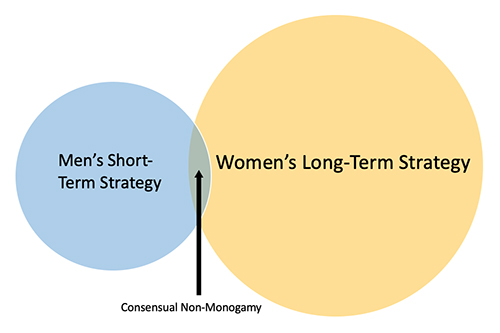
Subset Strategies
Humans also have “subset” mating strategies or mating behaviors that intersect with basic long and short-term strategies, including serial mating and extra-pair copulation (EPC) – i.e. infidelity or consensual non-monogamy. Which mating strategy is adopted very much depends on individual mate value. Those higher in mate value can more easily implement their preferred mating strategy. In general, higher mate value women focus even more on a long-term strategy and higher mate value men may focus even more on a short-term strategy. Mating strategy can also be influenced by the sex ratio in the local mating pool and operation of social/cultural norms in the local environment.
Humans Employ Strategic Pluralism
Ultimately, what people want in a long-term mate can be quite different from what they want in a short-term mate. Humans employ “strategic pluralism” — a variety of strategies and tactics when it comes to mating. There are multiple routes to mating success.
Women’s Long-term Strategy
Women’s long-term mating is driven by genetic characteristics and interests of our species: internal fertilization, an extended period of gestation, prolonged infant dependence on mother’s milk, and the need for relatively “high” male parental investment compared to other primates. In addition to protection and a provision of resources, a woman’s long-term strategy seeks character traits that ensure stability and loyalty to her and her children over the long-term.
Trade-offs Between Resources and Character
What is often more salient in female mate selection and relationship satisfaction is the tension between the two preferences inside the female long-term strategy: resources and character. A woman’s long-term mating strategy often involves ambivalence and internal confusion related to her desire for a mate with resources and status, and her preference for loyalty, kindness, intelligence, and character traits for parenting. (See “trade-off boundary” on diagram below.) In America, resources usually win this game of mate selection preference, often with rationalization and denial about the lack of optimal character.
Diagram #2: Women’s Long-term Mating Strategy
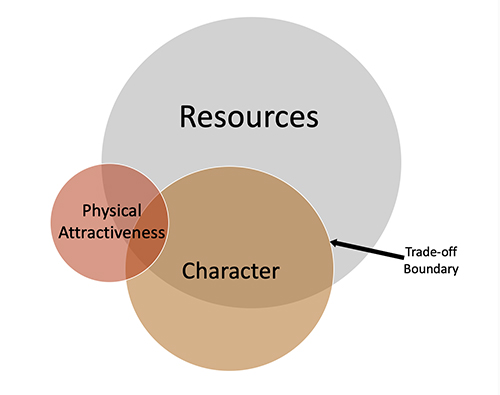
Benefits of Women’s Long-term Mating Strategy
- Significant resources from mate
- Parental investment
Costs of Women’s Long-term Mating Strategy
- Restricted sexual opportunity
- Sexual obligation to mate
The benefits far outweigh the costs and have pre-eminent value in female mate selection — and thus overall power to influence sexual access and all domains of male behavior.
Women’s Short-term Strategy
Women are found to prefer features related to muscularity, strength, fitness, and masculinity – traits associated with symmetry, in their short-term mates. They also look for stable character traits (minimal levels of generosity and kindness) and a fair amount of resources. While the following gives considerable attention to the complexities of a woman’s short-term strategy, it bears repeating that this strategy is not dominant in female mate selection; it is secondary and selective.
Diagram #3: Women’s Short-term Mating Strategy
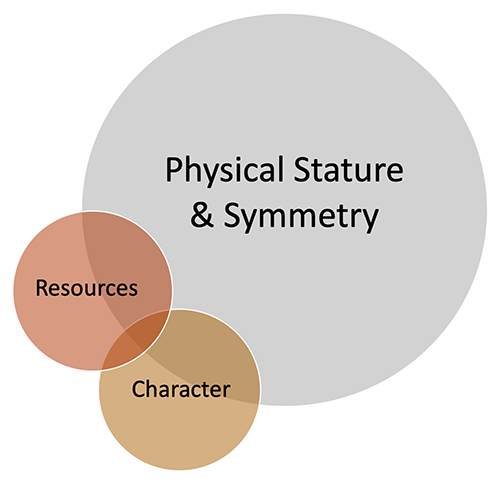
Benefits of a Woman’s Short-term Strategy
Women have a short-term mating strategy that brings several benefits. According to David Buss (Evolutionary Psychology, The New Science of the Mind, 1999), there are three classes of benefits (among a few other hypotheses) that are supported by research:
- Resource acquisition. Women could engage in short-term mating for the immediate exchange of meat, goods, or services. Ancestral women may have also engaged in short-term mating in order to obscure the paternity of her offspring (“paternity confusion”) and elicit resources from more than one man. In addition, short-term mating may have brought protection (a resource) from other males when the primary mate was not present.
- Genetic benefits. Short-term mating potentially brings enhanced fertility. It may also bring superior or diverse genes from a high-status male, thus giving offspring a better chance of survival against environmental change. Also, the “sexy son” hypothesis suggests that male progeny of such men are very attractive to women in the next generation, thus securing a positive genetic legacy.
- Physical Stature Equals Genetic Fitness. Women’s prioritization of physical features in short-term partners is consistent with strategic pluralism theory that says women may seek genetic fitness in short-term partners. (Gangestad and Simpson, 2000). According to this “good genes” theory (Thornhill and Gangestad, 1993), women are attracted to men who effectively advertise having genes that are resistant to local pathogens.
- Ovulation and Short-term Mating Success. Research has found that women value such characteristics (including the scent of symmetrical men) even more around the time of ovulation. As a result, symmetrical and muscular men have greater short-term mating success compared to their relatively asymmetrical and non-muscular peers. They have more sexual partners and are more desirable as affair partner.
- Mate Switching Hypotheses. While preferences for traits associated with high-testosterone (muscularity, strength and facial symmetry) tend to support the hypothesis that women seek genetic benefits in short-term mating, recent research and DNA evidence has cast some doubt on this as a motivation and has drawn more attention to the “mate switching hypothesis.” (See Mate Switching Hypothesis).
David Buss (Evolutionary Psychology, The New Science of the Mind, 1999) identifies three reasons for a woman’s short-term mating strategy (infidelity or extra-pair copulations) that confirm a mate switching hypothesis.
Hit the Road Jack
One study found that extra-pair mating made it easier for a women to break up with their current partner — what Buss calls “mate expulsion.” David Buss and Cindy Meston report (Why Women Have Sex, 2009) that women have affairs to test the waters to see if there is someone better out there for them, in an attempt to “trade-up” for a better partner. Women have affairs if they think their relationship may be dissolving. And women cultivate “back-up mates.” As Buss likes to joke in quoting a female research participant, “men are like soup; you always want to have some on the back burner.”
From a Short “Flight” to a Long “Flight”
According to “sexual strategies theory” (Buss and Schmitt, 1993), by being open to short-term relationships, women can increase their options for long-term ones. They can solicit the interest of many men and use this wider net to evaluate long-term mates, or they may be able to turn short-term relationships into long-term ones. If women use short-term mating to assess or attain long-term relationships, they may prioritize the same traits in short-term partners that they prioritize in long-term partners.
More Clues to Mate Switching and Sex Differences
There are other clues to explain the infidelity (short-term mating strategy) of women as reported by Buss –clues that fortify a mate switching objective.
- Women who are sexually or emotionally unhappy have affairs. This is not true for men. Men do not often report marital unhappiness as a reason for an affair. According to Buss, men can be relatively happy in their marriage and still have affairs. The issue of emotional dissatisfaction appears to be specific to women.
- 70% of women become emotionally involved with or fall in love with their affair partner. In contrast, only about 30% of men do.
- As stated above, qualities desired by women in an affair partner are often similar to the qualities desired in a long-term mate. Women want character traits (e.g. kindness) and resources in an affair partner, just not as much as in a long-term mate. This is not true for men. For example, women usually want intelligence in an affair partner. For men, intelligence in an affair partner is mostly irrelevant. Desiring the same qualities in an affair partner further supports a view that the female long-term mating strategy is significantly more adaptive in evolution than the short-term mating strategy.
Self-esteem in Women
Studies have shown that a woman’s self-esteem is a significant predictor of short-term-mating. Women scoring low on self-esteem tended to have a greater number of sex partners, one-night stands, and a preference for short-term sexual relationships.
Costs of Women’s Short-term Strategy
- Risk of a sexually transmitted disease
- Risk of pregnancy
- Reduced value as long-term mate
- Greater risk of physical and sexual abuse
- Risk of withdrawal of resources from husband
While the benefits noted above seem compelling, the costs of a woman’s short-term mating strategy far outweigh the benefits and produce a “response desire” and “braking” pattern of female sexual response. These costs directly influence female sexual response and sexual psychology. (See Spontaneous and Response Desire – the Underbelly of Heterosexual Mating.)
Men’s Short-term Strategy
“There seems to be no question but that the human male would be promiscuous in his choice of sexual partners throughout the whole of his life if there were no social restrictions. The human female is much less interested in a variety of partners.” ~ Alfred Kinsey
Evolutionary adaptation has dictated a preference by men for a short-term mating strategy. Trivers’s (1972) theory of parental investment and sexual selection provides a powerful reproductive basis for expecting sex differences. Men, more than women, are predicted to have evolved a greater desire for casual sex and a variety of partners. The same act of sex that causes a woman to invest nine months of internal gestation obligates the man to practically no investment.
Premium On Female Beauty
Men’s short-term strategy puts an immense premium on physical beauty and fertility. Character traits required of a woman are minimal (i.e. “don’t be dangerously crazy”) and resources are not required at all. Men’s short-term strategy is more predominant than their long-term strategy, but the difference is less pronounced behaviorally in modern times.
Diagram #4: Men’s Short-term Mating Strategy
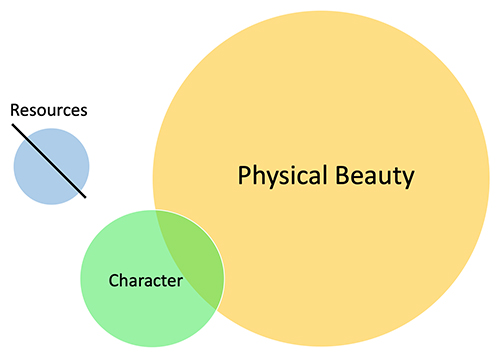
Restraints on Men’s Short-term Mating Strategy
Although men could potentially conceive more offspring if they were promiscuous instead of monogamous, there may have been at least two restraining factors of evolution against male promiscuity. Reproductive success depends on the survival of one’s offspring. Children have a better chance of survival if two parents contribute. Men who were highly promiscuous may not have been able to support all their offspring, and thus may not have been as genetically successful as more monogamous men.
Women Have to Consent
As suggested by Roy Baumeister and Dianne Tice (The Social Dimension of Sex, 2001), a second possible restraining factor on male promiscuity is an obvious one: the question of whether a male can get a lot of potential mates if females won’t consent to mate with him.
Promiscuous Male At Possible Disadvantage
Men not predisposed to mate in long-term relationships might not have left enough offspring for a totally promiscuous genetic tendency to proliferate. According to Baumeister and Tice, males thus evolved to mate in long-term relationships to raise their children to adulthood, and also evolved a tendency to be more open than females to a wider variety of mating opportunities. Perhaps this greater need for compromise between monogamy and promiscuity can also explain why men have a greater variety of sexual practices and interests than women.
Put A Ring On It
David Buss suggests (Evolutionary Psychology, The New Science of the Mind, 1999), that men, even in ancestral times, who failed to commit might not have attracted any women at all. Women’s requirement for consenting to sex could have made it costly for men to pursue a short-term strategy exclusively. In the economics of reproductive effort, the costs of not pursuing a permanent mate may have been prohibitively high for most men.
High Mate Value Men Like Short-term Mating
High mate value men (on the “Self-perceived Mating Success Scale”) tended to have sex at an earlier age, a greater number of sex partners, and more sex relative to their lower mate-value counterparts. And high mate value men scored higher on the “Sapiosexuality Inventory” suggesting that they are pursuing a short-term mating strategy. These are measures of the holy grail of sexual turn-on for women: self-confidence. This is what “cocky” really means. (BTW, penis size does indeed contribute to this self-confidence — to being “cocky.” (See Undiscussables.)
Men Lower Their Standards
Buss and Schmitt (1993) found that men desire more partners and lower their standards for short-term mating. Men in this study expressed lower standards than women on forty-one of the forty-seven characteristics named as potentially desirable in a casual mate. For brief encounters, men required a lower level of charm, athleticism, education, generosity, honesty, independence, kindness, intelligence, loyalty, sense of humor, sociability, wealth, responsibility, spontaneity, cooperation, and emotional stability.
Closing Time Phenomenon
Relatedly, men shift perceptions of attractiveness near closing time in a singles bar regardless of how much alcohol they have consumed. With this “closing time phenomenon,” women just look better and better as the night wears on. In contrast to men, most women can obtain a desirable temporary mate without having to relax their standards at closing time.
Sex Ratio Effect on Short-term Mating for Both Sexes
Men shift to brief encounters when more women are sexually available (positive sex ratio), satisfying their desire for variety. Correlated to that, women on college campuses today will shift toward more short-term mating because the surplus of women causes more intra-sexual competition. When there is a surplus of men, in contrast, both sexes shift toward a long-term mating strategy marked by stable marriages and fewer divorces.
Benefits of Men’s Short-term Strategy
- Potential to reproduce; more sex partners
- No parental investment
Costs of Men’s Short-term Strategy
- Risk of sexually transmitted diseases
- Some resource investment
- Less protection for genetic children
- Acquiring a reputation as a womanizer
- Suffering violence from husbands, brothers or fathers
- Retaliatory affairs by wives or a costly divorce
The benefits of the male short-term mating strategy have shaped the evolution of male neurology and physiology and influenced male behavior, especially sexual initiation and intra-sexual competition. But costs do mitigate this strategy, especially in modern times.
Men’s Long-term Strategy
For long-term mates, men still put a premium on physical beauty and markers of health and fertility for initial attraction. Buss and Schmitt (1993) studied 37 cultures and confirmed the universal desire for physical attractiveness in a long-term mate. But men also want a woman who is faithful and kind. Resources are considered but are usually a distant third in importance. As stated above, men who are willing to commit to a long-term relationship have a wider range of women from which to choose.
Marriage in the U.S. Favors Men With Resources
As discussed in Dynamics in the Mating Economy: Domain #1 of Male-Female Difference, marriage patterns in modern America confirm the fact that men with resources are most able to actualize their preferences.
Diagram #5: Men’s Long-term Mating Strategy
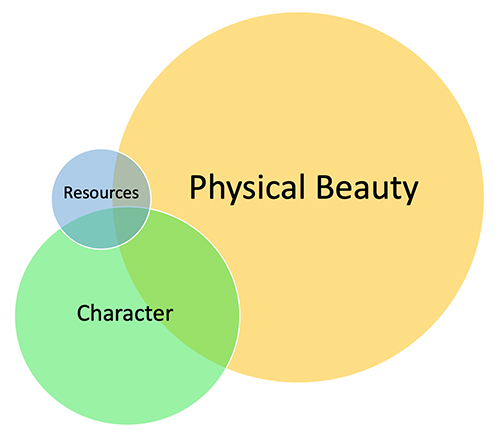
Benefits of Men’s Long-term Strategy
- Increased paternity certainty
- Improved social competitiveness of children
- Sexual and social companionship, especially for “beta” males
Costs of Men’s Long-term Strategy
- Restricted sexual opportunities
- Heavy parental investment
- Heavy relationship investment
The benefits of men’s long-term mating strategy tend to outweigh the costs in most cultures in modern times. Pair-bonding and relative monogamy is the norm in most modern societies.
References
Buss, D. M., (1999). Evolutionary Psychology, The New Science of the Mind.
Buss, D. M. & Schmitt, D.P. (1993) “Sexual strategies theory: An evolutionary perspective on human mating.” Psychological Review, 100, 204-232.
Clark, R. D. & Hatfield, E. (1989). “Gender differences in receptivity to sexual offers.” Journal of Psychology and Human Sexuality, 2, 39-55.
Dibble, et al (2015, June 11). “Simmering on the back burner: communication with and disclosure of relationship alternatives.” Communication Quarterly, 63(3), 329-344.
Gangestad, S.W. & Simpson, J.A. (2000). “The evolution of human mating: Tradeoffs and strategic pluralism.” Behavioral and Brain Sciences, 23, 573-587.
Li, P. (2008). “Intelligent Priorities: Adaptive Long- and Short-term Mate Preferences,” in Mating Intelligence, eds., Geher, G., & Miller, G.
Thornhill, R., & Gangestad, S..W. (1993). “Human facial beauty: Averageness, symmetry and parasite resistance.” Human Nature, 4, 237-269.
Trivers, R. L. (1972). “Parental investment ad sexual selection.” In B. Campbell (Ed.), Sexual Selection and the Descent of Man, (pp.136-179).
Appendix
Domains of Male-Female Differences in Sexual Psychology
1. Behavioral dynamics in the mating economy
2. Long-term vs. short-term mating strategies
3. Trait preferences and priorities for mate selection
4. Physical attraction and perceptions of beauty
5. Concordance between physiological response and psychological desire
6. Spontaneous desire vs. response desire
7. Sex and love-making that fuels desire
8. Accelerator vs. brake: sexual excitation and inhibition systems
9. Brain structures: sexual pursuit and visual stimuli
10. Hormonal differences
11. Variety and novelty
12. Sexual mentation and “sex drive”
13. Influence of context
14. Female competing intentions and imposed double bind
15. Sexual orientation (and preference) fluidity and response variability
16. Orgasm – purpose and characteristics
17. Meta emotions
18. Romance and desire, together and apart
19. Psychology of monogamy
20. Infidelity – reasons and response
21. Jealousy – triggers, tactics, and consequences
22. Sexual fantasies
*Assumptions of Mating Straight Talk
- Men and Women have similarities as human beings, and aggregate differences from each other, that are primarily a function of biology and evolutionary adaptation. Our similarities do not often cause conflict. But our differences, and the denial of those differences, often cause “trouble”.
- Men and Women have differences that we must acknowledge and understand in order to have satisfying heterosexual (romantic and sexual) relationships.
- Men and Women have differences that we must acknowledge and understand in order to bring clarity to the “politics” of sex and gender.
- Men and Women need “straight talk” (radical honesty) in order to uncover and accept our differences.
- Men and Women need straight talk about our differences in order to empower one another for co-creative relationships.
3 Comments
Submit a Comment
Please Note: Your comment may take up to 12 seconds to register and the confirmation message will appear above the “Submit a Comment” text.

I like the addition of the “At-a-Glance Summary” section, Steven. That title plays off of the introductory research experience and also leads into the themes of short- and long-term mating strategies in intriguing ways. With a large enough sample and some technological tools, an interesting experiment might be to track how far men read through this entry compared to women. Does a predominantly “short-term strategy” play out in other domains than sexual mating? Would the investment of time and attention show up in areas beyond the focus of this blog? Just some curiosity here, no real evidence that I know of to support that speculation. And, finally, the photo and graphics do add to this post right from the start!
Tobin, thank you for the very interesting question about a wider application of short-term psychology. Alpha males, high mate value males, may pursue more short-term strategies in the context of (intra-sexual) competition. So that crosses over into all domains of business, commerce, and power acquisiton. I have written on this site about the “dark-triad” characteristics and dominance-oriented male personality which my have less impuse control and less long-range objectives. I will be exploring this and other Big 5 personality related issues in the coming piece on evolutionary psychchology and our political divide.
I am so glad that so many lovely women went along with my short term strategy. It was delightful and there was not too much regret.